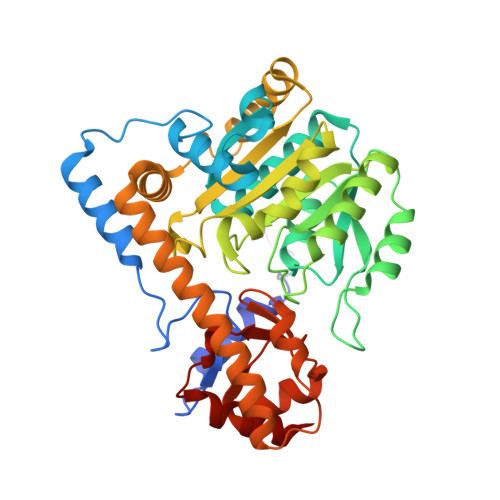Structure and Mechanism of a Cysteine Sulfinate Desulfinase Engineered on the Aspartate Aminotransferase Scaffold.
Fernandez, F.J., De Vries, D., Pena-Soler, E., Coll, M., Christen, P., Gehring, H., Vega, M.C.(2011) Biochim Biophys Acta 1824: 339
- PubMed: 22138634
- DOI: https://doi.org/10.1016/j.bbapap.2011.10.016
- Primary Citation of Related Structures:
3ZZJ, 3ZZK, 4A00 - PubMed Abstract:
The joint substitution of three active-site residues in Escherichia coli (L)-aspartate aminotransferase increases the ratio of l-cysteine sulfinate desulfinase to transaminase activity 10(5)-fold. This change in reaction specificity results from combining a tyrosine-shift double mutation (Y214Q/R280Y) with a non-conservative substitution of a substrate-binding residue (I33Q). Tyr214 hydrogen bonds with O3 of the cofactor and is close to Arg374 which binds the α-carboxylate group of the substrate; Arg280 interacts with the distal carboxylate group of the substrate; and Ile33 is part of the hydrophobic patch near the entrance to the active site, presumably participating in the domain closure essential for the transamination reaction. In the triple-mutant enzyme, k(cat)' for desulfination of l-cysteine sulfinate increased to 0.5s(-1) (from 0.05s(-1) in wild-type enzyme), whereas k(cat)' for transamination of the same substrate was reduced from 510s(-1) to 0.05s(-1). Similarly, k(cat)' for β-decarboxylation of l-aspartate increased from<0.0001s(-1) to 0.07s(-1), whereas k(cat)' for transamination was reduced from 530s(-1) to 0.13s(-1). l-Aspartate aminotransferase had thus been converted into an l-cysteine sulfinate desulfinase that catalyzes transamination and l-aspartate β-decarboxylation as side reactions. The X-ray structures of the engineered l-cysteine sulfinate desulfinase in its pyridoxal-5'-phosphate and pyridoxamine-5'-phosphate form or liganded with a covalent coenzyme-substrate adduct identified the subtle structural changes that suffice for generating desulfinase activity and concomitantly abolishing transaminase activity toward dicarboxylic amino acids. Apparently, the triple mutation impairs the domain closure thus favoring reprotonation of alternative acceptor sites in coenzyme-substrate intermediates by bulk water.
Organizational Affiliation:
Centro de Investigaciones Biológicas, Consejo Superior de Investigaciones Científicas (Spanish National Research Council, CSIC), Madrid, Spain.

















